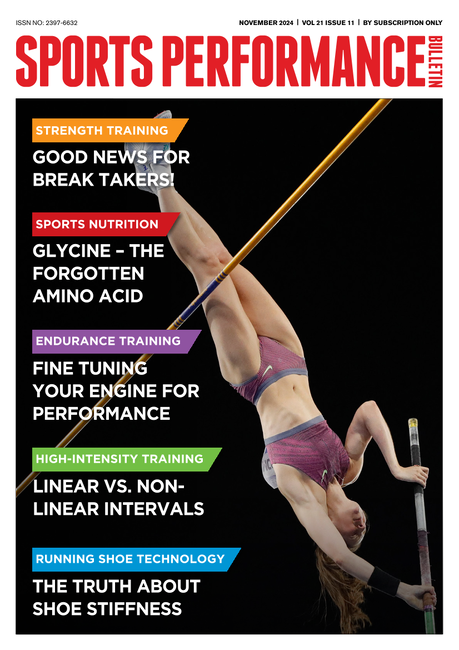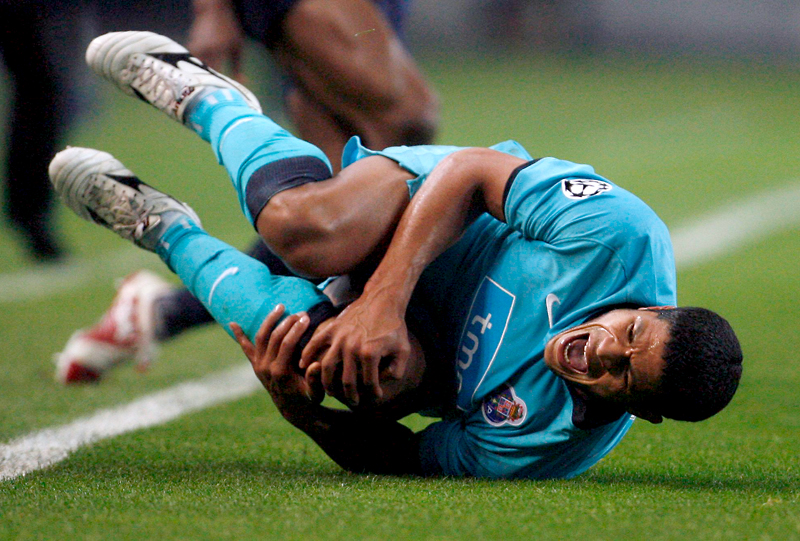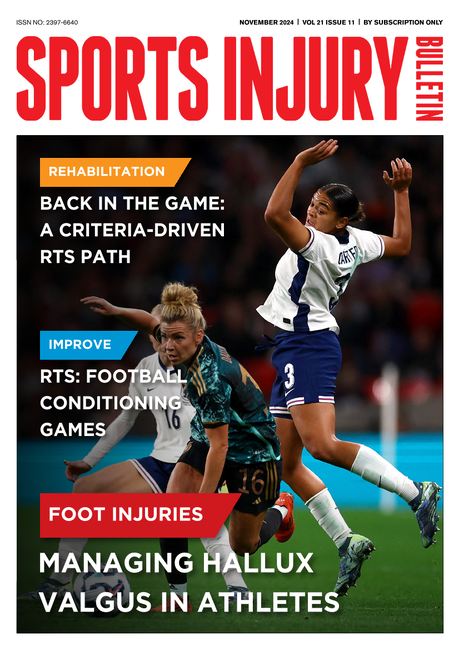About 85 per cent of elite and recreational badminton players (!) are injured during an average year, 65 per cent of regular runners are hit by the injury bug, and 21 percent of walkers are afflicted (by definition, an 'injury' is a physical problem severe enough to force a reduction in training).
A variety of other sports are ranked below, with the number of injuries per 1000 hours of activity in parentheses ('Injuries in Recreational Adult Fitness Activities,' The American Journal of Sports Medicine, vol. 21 (3), pp. 461-467, 1993).
1. Alpine skiing (8)
2. Rowing machine exercise (6)
3. Treadmill walking or jogging (6)
4. Tennis (5)
5. Dancing classes (5)
6. Resistance training with weight machines (4)
7. Resistance training with free weights (4)
8. Outdoor cycling (3.5)
9. Stationary cycle exercise (2)
10. Stair climbing (2)
11. Walking (2)
Of course, injuries in sports such as rugby and lacrosse are often the result of impacts with other players - or with other players' equipment, as in squash. Such injuries are often very difficult to avoid. Your body may be strong, flexible, and injury-resistant, but if another player's racket catches you in the eye, you're going to be hurt, no matter how well prepared you are.
However, in sports such as running, cycling, swimming, stair climbing, and walking, most injuries are not the result of sudden catastrophes but occur because of what is popularly called 'overuse'. This is one way of saying that a key part of an athlete's body simply can't stand up to the regular pressures of training and competition without breaking down.
Take running as an example
To think about how such injuries can be prevented, it is instructional to consider the sport of running, which can certainly be classified as a high-injury sport. As mentioned, 65 percent of runners are injured in an average year, one running injury occurs for about every 100 hours of running, and runners miss about 5-10 per cent of their workouts due to injury ('Incidence and Severity of Injury Following Aerobic Training Programs Emphasising Running, Racewalking, or Step Aerobics,' Medicine and Science in Sports and Exercise, vol. 25(5), p. S81, 1993).
Those very high 65-per cent-injury and 10-per cent-absence rates could probably be significantly lower - if runners knew more about the actual causes of injuries, made a few simple adjustments in their training schedules, and routinely strengthened their muscles and joints. In fact, research suggests that running injuries could be cut by around 25 per cent (Sport for All: Sport Injuries and Their Prevention, Council of Europe, Netherlands Institute of Sports Health Care, Oosterbeek, 1989).
But what specific steps should be taken? To understand how to prevent injuries, it is first necessary to clear away some misconceptions. For example, coaches and runners often believe that males have higher injury rates than females, but male and female runners actually have about the same injury rate per hour of training. Large numbers of runners believe that training speed, racing speed, running surface, and body weight are closely related to the risk of injury, but research suggests otherwise. If you're heavier than average, you're not more likely than a lightweight runner to be injured during a typical year of training, for example. Likewise, if you carry out most of your training on concrete roadways, you're probably not hurt more often than the runner who pads along softly on forest trails. In addition, your foot-strike pattern - whether you prefer to land on the heel or forefoot while running - doesn't have much impact on your injury risk (American Journal of Sports Medicine, vol. 16(3), pp. 285-294, 1988). Such factors are just not very important in predicting injury.
What about stretching?
Another common belief is that proper warm-ups and cool-downs and appropriate stretching exercises all help to reduce injury risk, but research is very equivocal on this point. In a recent study, 159 Dutch runners were taught how to warm up, cool down, and stretch effectively, while a second group of 167 similar runners received no 'injury-prevention' instruction at all. The warm-up and cool-down consisted of six minutes of very light running and three minutes of muscle-relaxing exercises, and the stretching, carried out twice a day for 10 minutes at a time, loosened up the runners' hamstrings, quadriceps, and calf muscles. However, over a four-month period, the injury rates were identical in the two groups, averaging about one injury per 200 hours of running, so the stretching, warm-ups, and cool-downs had no protective effect at all ('Prevention of Running Injuries by Warm-Up, Cool-Down, and Stretching Exercises,' The American Journal of Sports Medicine, vol. 21(5), pp. 711-719, 1993). This study was carried out with endurance runners; in sprint performers the results might be quite different.
Interestingly enough, a second study showed that stretching could actually be associated with a higher risk of injury. In research carried out at the University of Hawaii, runners who stretched regularly were about 33-per cent more likely to be injured compared to those who never stretched (see Sports Performance Bulletin, issue 46, July 1994). However, this same investigation determined that stretching carried out AFTER workouts actually lowered injury risk, while pre-workout stretching increased it. To be protective, stretching apparently must be conducted when muscles are warm and less viscous - and therefore less resistant to being stretched out.
Aside from stretching after workouts, what other steps can be taken to tone down injury rates? Well, remember that any sport has an injury rate per hour of activity which is specific to that sport. In the case of running, for example, the rate is about one per 100 hours of participation. Of course, that means that total time spent training per week can be a pretty good predictor of injury. The runner who trains three hours of week will take about 33 weeks to get injured, for example, while the individual who works out five hours per week will limp to the sidelines about once every 20 weeks. More training simply means more repetitive stress to the 'weak link' in the body which is prone to injury. It's not surprising that studies carried out with runners uncover the highest injury rates in individuals who run more than 40 miles per week.
Avoid too many consecutive days
So, limiting training is an easy answer to the injury bug, but how many of us really want to take part in less of what we truly enjoy? As long as we're not overtraining, the solution should lie elsewhere. And one key clue to the riddle is that a very strong predictor of injury is the number of consecutive days of training you carry out. The more consecutive days, you have, the higher your chances of getting hurt.
Consecutive days are counted as follows: if you train on Monday, Tuesday, Wednesday, and Friday, you are training on three consecutive days each week (Friday doesn't count because it has a rest day before and after it). Studies show that reducing the number of consecutive days lowers the risk of injury. This means that if you train for one hour every day from Monday through Friday (five consecutive days), you could reduce your risk by completing 75- minute workouts on four days per week (Monday, Wednesday, Friday, and Saturday, for example). Your total training time (and gain in fitness) would be the same in each case, but the second strategy would reduce your consecutive days from five to two, giving you much more average recovery time between sessions and a lower risk of injury.
Exercise scientists believe that the key problem with too-many consecutive days is that they don't give your muscles and connective tissues a regular, substantial block of time during which they can knit themselves back together after being punished by strenuous training. Giving your sinews predictable 48-hour stretches of relief (which is basically what they get when you schedule a rest day) allows more healing to occur, so that small angry knots of connective tissue don't flare up into major injury problems.
Another key point to consider is that studies often find an inverse relationship between injury risk and the number of years involved in athletic activity. Basically, relative newcomers to a sport are significantly MORE likely to be injured than individuals who have been training for many years (American Journal of Sports Medicine, vol. 16(3), pp. 285-294, 1988, and also Archives of Internal Medicine, vol. 149 (11), pp. 2565-2568, 1989). Although these observations seem to contradict the idea that total hours of training are a good predictor of injury (since veteran athletes tend to train more than novice competitors), they are giving us a critical piece of information. Basically, they are telling us that strength is important in reducing injury risk. After all, more experienced athletes are STRONGER and more coordinated than the beginners because of their years of training, and this strength and coordination appears to offer real injury-prevention value. Upgraded strength protects and stabilises joints and prevents muscles and connective tissues from literally being torn apart by the repetitive forces placed on them during activity.
The final key to the puzzle is that just 50 per cent of sports injuries are actually new trouble areas; the rest are recurrences of previous problems (Archives of Internal Medicine, vol. 149(11), pp. 2561-2564, 1989). This certainly tells us that athletes are not taking care of their injuries properly. An injury should be more than just an annoyance: it should be a warning signal that a body part is simply not strong enough. The fact that injuries tend to re-occur means that athletes are not doing a good job shoring up those regions of the body that are prone to problems.
A palliative, not a cure
Indeed, most athletes take a totally wrong approach to injury treatment and prevention. When an injury pops up, they do practise the principles of 'ARI' - anti-inflammatories, rest, and icing, and these remedies do tone down the severity of an injury. However, the real problem is that many athletes believe that these therapies are the 'cure' for their athletic wounds. The truth is that ARI simply allows athletes to return to the precise activities and movement patterns which maimed them in the first place. Small wonder that 50 per cent of injuries are re-occurrences! Sports-active people need to strengthen - not just rest and ice - vulnerable body parts, so that those areas will hold up to future training stresses.
Scientific support for strength training as an injury preventer is very strong. For example, studies carried out with tennis players reveal that athletes who do not carry out regular resistance training have a higher incidence of common injuries such as 'tennis elbow'. In addition, competitors who undergo a preventative resistance training program AFTER developing tennis elbow have only about a 30-per cent re-occurrence of symptoms, compared to 41 per cent in those who don't strength train ('An Epidemiological Study of Tennis Elbow,' American Journal of Sports Medicine, vol. 7, pp. 234-238, 1979).
In the sport of swimming, research carried out at the University of Ohio reveals that poor strength in the external rotator muscles of the shoulder is a strong predictor of shoulder injury; the lower the strength, the higher the risk. In addition, isokinetic exercises to increase the strength and endurance of the shoulder muscles reduce the frequency of shoulder problems in competitive swimmers (American Journal of Sports Medicine, vol. 8, pp. 151-158, 1980).
So, to keep your body free from injury, it must be strong, and to prevent an injury re-occurrence, the damaged area must be totally revamped. The key, however, is not to increase GENERAL strength but actual strength during those movements which are required and appropriate for your sport. That means specific, weight-bearing, closed-chain resistance training which forces the muscles in your body to function powerfully and in synchrony, as outlined, for instance, in Owen Anderson's Achilles-heel article later in this injury-preventing special issue of Sports Performance Bulletin.
Dick Travisano









